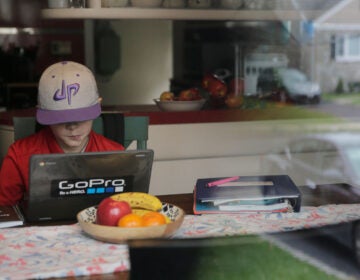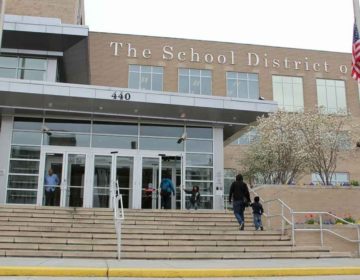The diary of Ms. B.: Tears and triumphs inside a Philly teacher’s virtual classroom
Lauren Ballester is among the thousands of Pa. teachers trying to figure out online education. Her first week was an adventure of emotions.
Listen 5:00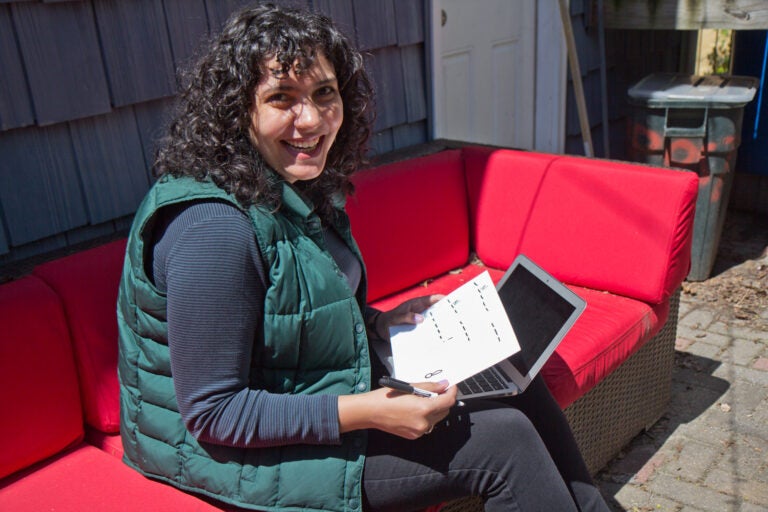
Ballester plays a hang-man style game with students, solving a puzzle related to a lesson they're working on. (Kimberly Paynter/WHYY)
WHYY and The Notebook will be periodically checking in with two teachers for the rest of the academic year to see how they are coping with the move to virtual learning. We hope to recount their successes, discoveries, and frustrations. This is the second story in the series.
—
On a Wednesday afternoon, sixth-grade teacher Lauren Ballester stared into an empty video call and laughed to herself.
The Google Hangout screen in front of her stated the obvious:
“You are the only one here.”
“Yes, Google,” the second-year teacher said, with mock annoyance. “I know.”
Ballaster, a reading and social studies teacher at William H. Ziegler School in lower Northeast Philadelphia, was halfway through her first week of online education. Each day brought a cocktail of conflicting emotions: frustration, triumph, loneliness, hope.
At the moment, Ballester was stewing in self-deprecation and a touch of dark humor.
She was a young teacher in strange waters — seeking validation or at least some signal that whatever lines she’d cast into the digital ocean hadn’t simply sunk to the bottom.
But, the emotional tides of teaching can switch quickly — they had all week.
In this instance, a breakthrough was near, logging on from a computer 11 miles away.
***
As you read this, teachers across Pennsylvania are relearning how to do their jobs.
With physical schools closed through at least the end of the academic year, education has gone virtual. Teachers are quickly trying to master the technological tools needed to salvage a pandemic-wrecked school year.
For about a month, Philadelphia schools sat in different states of limbo — as the district distributed 75,000 Chromebook laptops to students who lacked home devices.
On April 20, the district officially opened up a “review and enrichment” period for teachers to test-drive their online classrooms. By May 4, the district says teachers will be expected to grade student work and hold daily classes online.
This will not happen by magic, but instead through the experimentation and persistence of educators.
Lauren Ballester, 26, is one of thousands trying to make it work.
With humility, humor, and abundant heart, Ballester allowed WHYY to chronicle her first week as an online teacher through interviews and audio diaries. This is her story.
The lead-up: Fear, fury, and fonts
On the Friday that became the final day of in-person school, Lauren Ballester was frantic.
She got word around 2 p.m. that Pennsylvania public schools would be closed for at least two weeks. She quickly went online, purchased a $4 work packet on figurative language, and ripped off enough copies for the 44 kids in her two class sections.
When she arrived back in her classroom, her sixth-graders were cheering “like it was two-weeks-worth of snow days.” But Ballester knew from conversations earlier that day that many of them weren’t as happy as they appeared.
“Some of them straight-up said, ‘Ms. B, I’m really scared,’” Ballester recalled.
Ballester had long wanted to be at a school like Ziegler, where 70% of students needed district-provided laptops in order to do online work from home.
She’d grown up in the Germantown section of Northwest Philadelphia with her mom, a teacher and part-time waitress. Scholarships carried her through private school K-12 and eventually the University of Pennsylvania, where she was the only Latinx person in her engineering program.
“When I was growing up, I always felt marginalized,” Ballester said.
Hoping to make the path easier for the next generation, Ballester was drawn to teach kids who “grew up like me, and kids who would find meaning in having a teacher who looks like them and comes from places like them.”
When Ballester first heard the district would mandate online learning, she was upset. Furious, really. She felt the last thing her kids needed in a global pandemic was to worry about schoolwork.
“I was so paralyzed with principled anger,” Ballester said.
Ballester had posted a few optional assignments when schools first closed, but the response rate was paltry. Of her 44 students, only three did the work.
She felt it was a sign that there were more important things in her kids’ lives than school. Even her check-up messages to the families felt, at times, intrusive.
When her anger subsided, she decided there was no point in half-measures.
“I’m gonna do it right,” she decided. “And I’m gonna do it in a way that makes me proud.”
So she burrowed into the planning process, meditating on the smallest details.
In class, she always used a template called “Marina” on her Google slides. She made sure to use that same color-font combination for each of the new slides she was now building.
“This is probably me being extra,” Ballester said. “They might not notice. But it’s comforting, even for me.”

‘Keep it 100’
Through “a lot of Google-ing and trial and error,” Ballester crafted a weekly assignment plan.
An app called Screenflick allowed her to create daily videos of her reading a book called “Inside Out and Back Again” aloud and going through slides related to the text. Another service called Epic! provided free online access to the book for her students.
Each day, the students had a reading prompt related to that day’s chunk of text.
Social studies class would revolve around daily journals the students would keep. They were, Ballester said, creating the “primary sources” future historians would use to learn about the coronavirus crisis.
The journal prompts changed daily, but they began with a series of check-in questions.
How are you feeling?
What did you do today?
What are you grateful for today?
What (or who) do you miss today?
Finally, as required by the school district, Ballester would hold online “office hours” for 90 minutes each day. Students could log onto her Google Hangout at any point during that window and chat with her.
Normally, Ballester liked to host “community circles” where students could share their feelings. Afraid that her kids were growing isolated, she wanted the journals to become that space for them to unload emotional burdens.
When the break first began, she’d sent a letter to her students. In it, she asked them to keep one simple thought at the center of their writing.
“Whatever you do, remember: Be true to yourself. Keep it 100. Speak your truth.”

Monday: ‘Weirdly nervous’
Jitters ran through Ballester’s fingertips as she flipped open her laptop on Monday. It was like walking into her classroom on the first day of school and wondering if anyone would even be there.
“I’m feeling weirdly nervous,” she said.
As an emotional hedge, Ballester decided to review student work during the window she’d designated for virtual office hours.
“That way, it’s not too depressing if nobody comes,” she explained.
Nobody came — so she started marking up the handful of assignments already submitted.
As she read through the responses, Ballester started to cry.
There were tears of relief — relief that more than three students had at least done the work. And there were tears of frustration, stemming from the fact that several students had written their reading responses about the wrong book.
It was the kind of error she could have corrected in 30 seconds on a normal day. “But now I feel like I’m grasping at straws just to be in touch with them all,” Ballester said.
About five times throughout the day she heard from families with some sort of log-in problem. It was inevitable in a world where assignments and materials were scattered across so many platforms: Google Drive, i-Ready, Lexia, BrainPOP…
At one point Ballester couldn’t get into her own account for a classroom management tool called ClassDojo.
Slowly, she worked through each hiccup. By 9 p.m. she was still at her laptop, watching assignments trickle in. She wished she could turn her brain off.
In all, 17 of 44 students completed the reading assignment and 18 did their social studies journals.
“Ok,” Ballester said. “I did a thing. And they did it.”
It was something — even if that something wasn’t quite school.
Earlier that day, one of her students had posted a public comment on the class portal that seemed to capture the moment.
“I miss everyone,” the student wrote. “I miss the teachers. I miss classmates. And I miss you 10,000 times every day.”

Tuesday: ‘Still a sixth-grade teacher’
The drama eased on Tuesday, and the realization set in: This is what school will be like for a while.
“The first day I was all nervous and had a lot of anticipation feelings,” Ballester said. “And now I’m like, ‘If this is gonna be my life for the next two months, I’m gonna get really bored.’”
Ballester was “thrilled” when she found a screen view on Google Classroom that allowed her to see, in one snapshot, how many students had turned in a given assignment.
“This is what my life has come to,” she said jokingly.
With school starting anew, Ballester and her colleagues found themselves questioning some of their most basic practices. On grading, for instance, she wondered if there should be two different marks — one for overall mastery of the subject and another just for effort.
Effort seemed to count for a lot right now.
In terms of participation, little had changed. She got 19 social studies assignments and 20 reading responses.
The quality varied.
One student wrote almost nothing about the book the class was reading. Instead, the student said she was “cracking up” at the names of two prominent characters: Ha and TiTi.
“Ok, I’m still a sixth-grade teacher,” Ballester thought upon reading the response.
Another student wrote in her journal that little had changed about her family’s life during quarantine “except that we can’t go to Coldstone Creamery and I’m really mad.”
Ballester could relate.
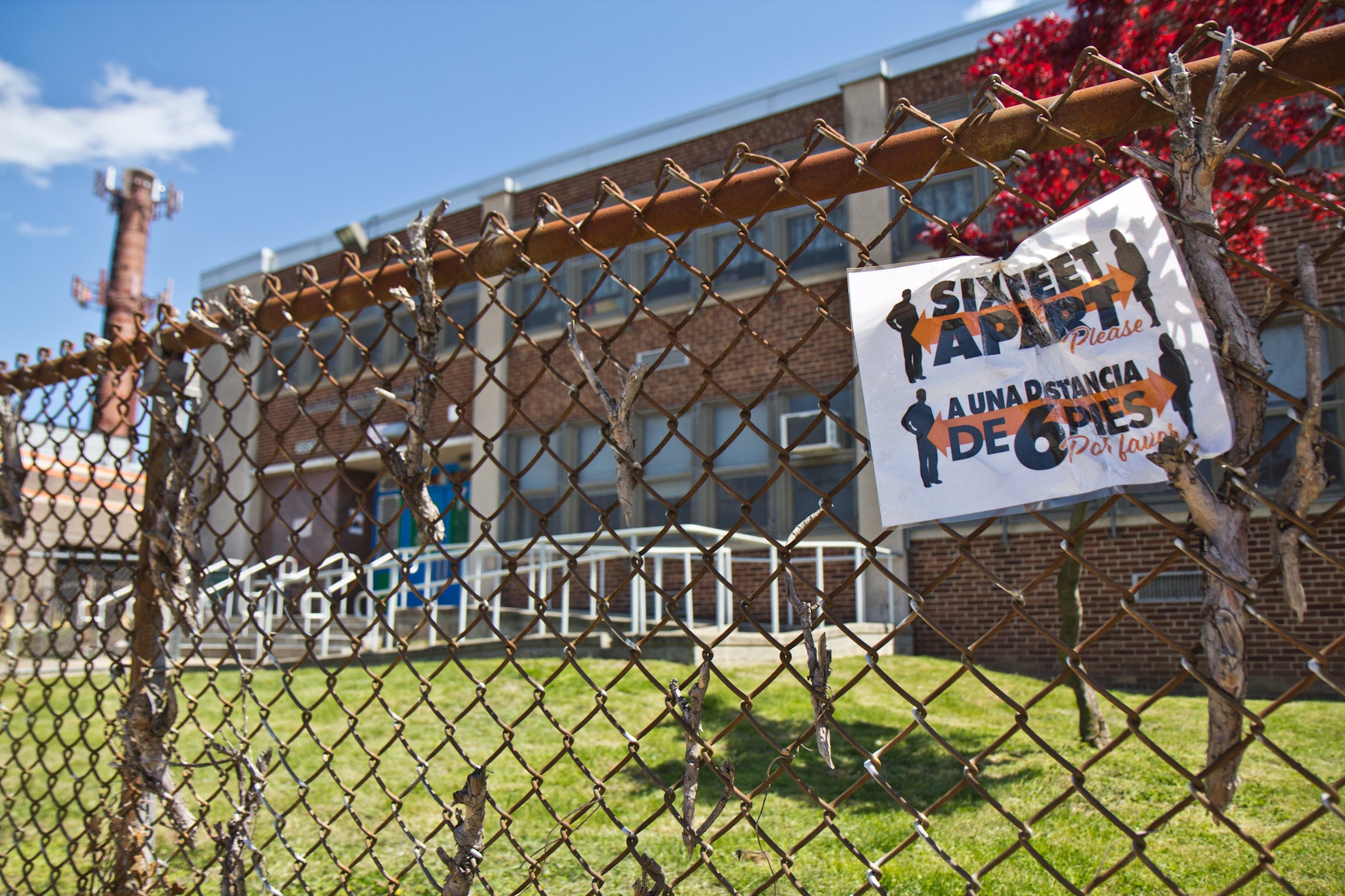
Wednesday: Peaks and valleys
Ballester woke to a text message from one of her students. Apparently the reading videos for Wednesday, Thursday, and Friday had no sound.
“I’m so angry I could scream,” Ballester said to herself in one of her audio diary recordings. “In fact, I have screamed.”
She didn’t know what exactly had gone awry, but the error forced her to spend the morning recording three different 20-minute videos for a second time.
Eight students turned in the assignment before she’d had the chance to correct the audio, which added to the misery. Was any of this even necessary?
“I’m feeling kind of defeated,” Ballester said.
When 1:30 p.m. arrived, for the third consecutive day, there were no students at online office hours. Google taunted. All Ballester could do was chuckle.
As she started to look through the day’s assignments, a face popped up on the screen. A girl named Iliana Rosa had logged on.
She didn’t have any questions with the work. Iliana was a diligent student. The girl just wanted to talk with her teacher. So they did — about the coronavirus and the magic tricks her brother was teaching her.
The conversation ran over an hour. It was the most meaningful interaction she had with a student in more than a month. When the call ended, Ballester struggled to describe the surge of emotion.
“I just…”
Sigh
“…continue to feel like it’s very hard to be a teacher. But it’s also very rewarding for moments like that.”
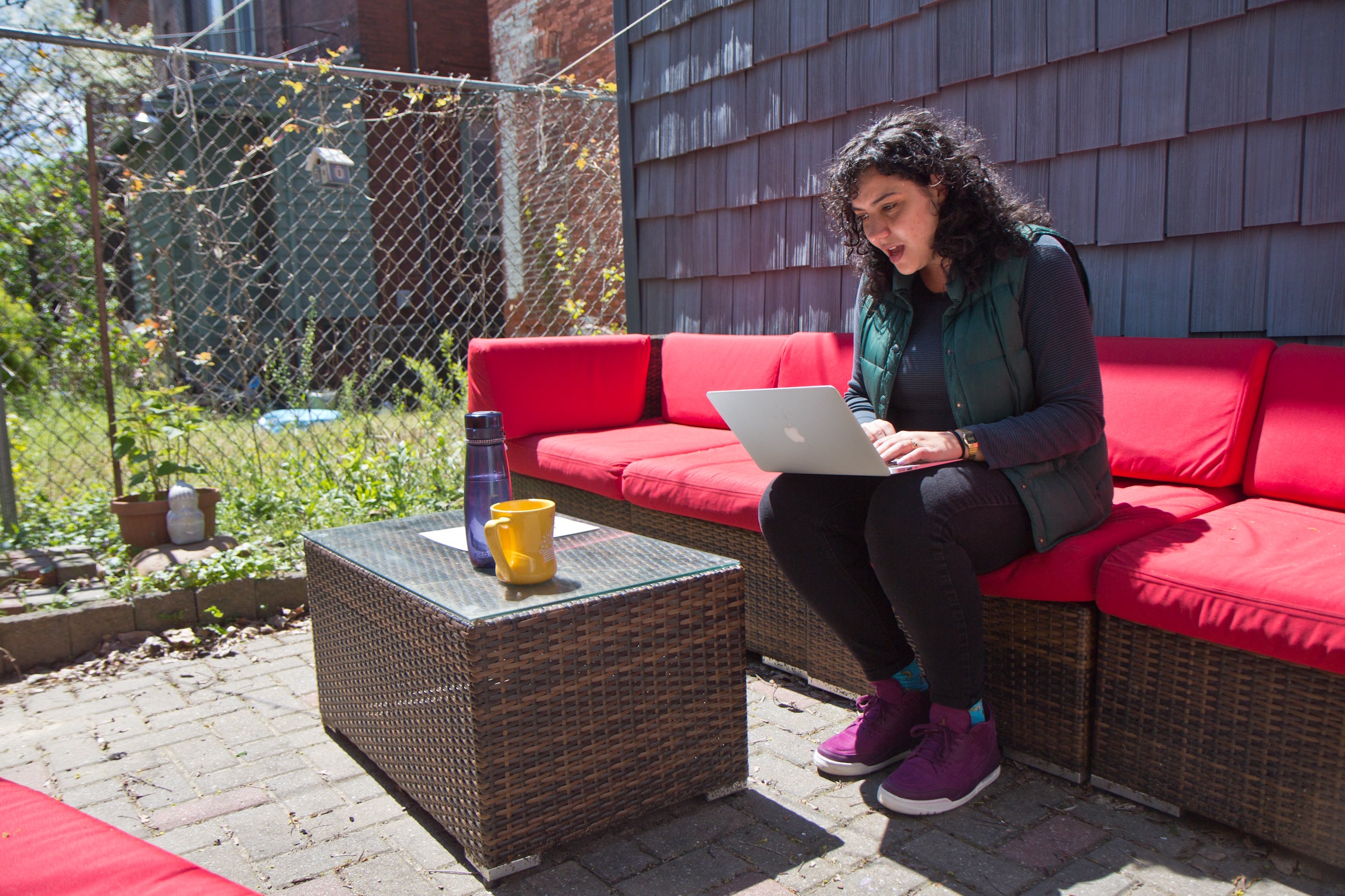
Thursday: Cranky days
Ballester spent Thursday in a funk. It wasn’t for any particular reason — just one of those glum days.
Normal school was like a performance. You had to put out good energy for the kids — even if you didn’t wake up with it.
Online school was different. Grumpiness could linger.
“I have cranky days at school, too,” Ballester said. “But it’s just really different to be stuck in your crankiness.”
The days weren’t as intense as hour after hour of managing live classes, but they dragged. Ballester found herself dialed into her laptop checking on student work late into the night.
Iliana Rosa provided a needed ray of sunshine when she showed up for office hours again. This time, she turned the tables on Ballester and asked her to answer the daily check-in questions the students had been asked to complete.
“Tell me, Ms. B, how are you,” Iliana asked. “How are you feeling?”
Ballester wasn’t sure how to answer.
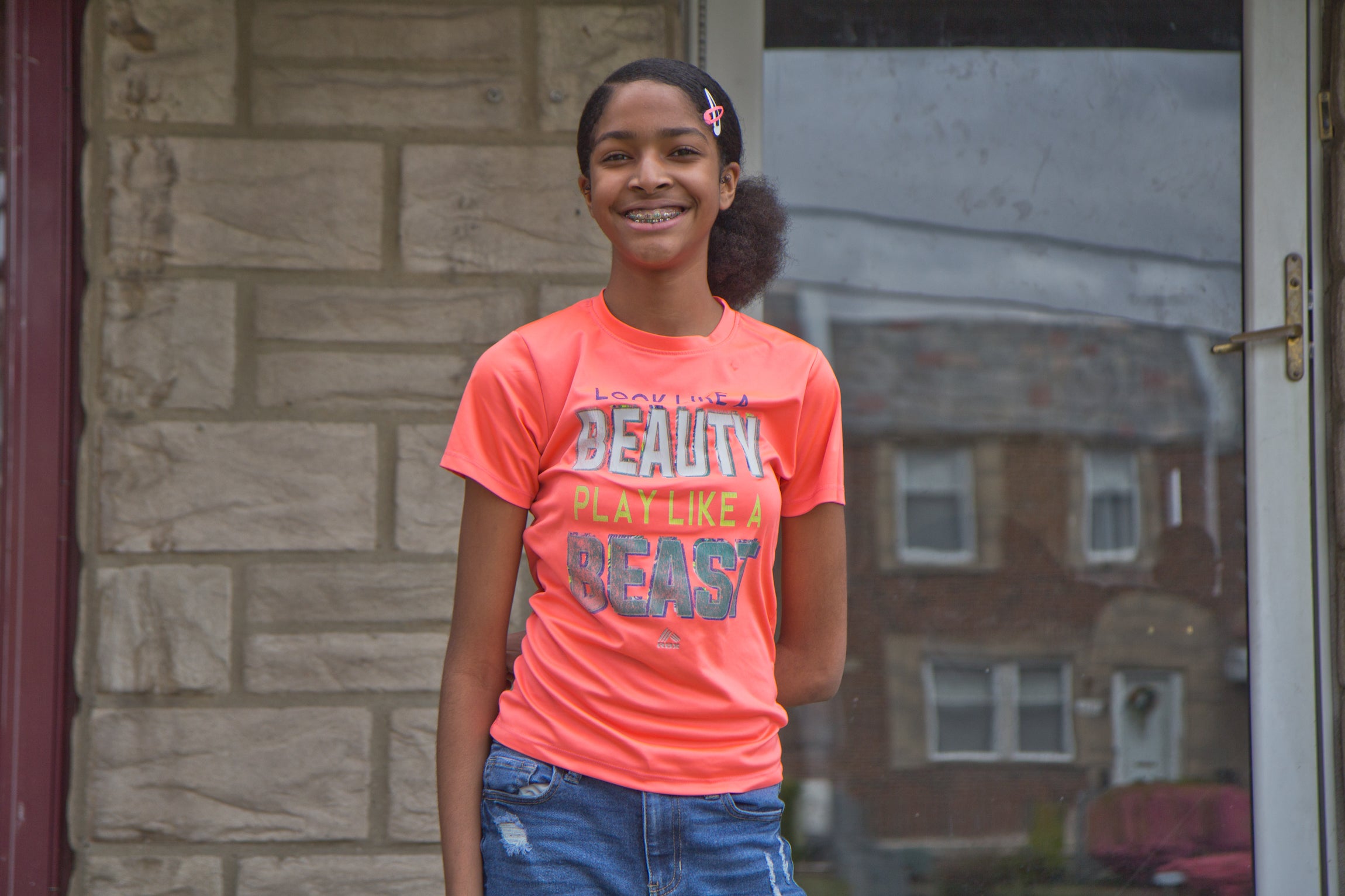
Friday: The “little organizer”
Ballester was running a couple of minutes late for office hours when she got a text from Iliana.
“Where are you?”
Iliana was running the show now. She’d convinced a friend from class to attend office hours with her.
“She’s like my little organizer — doing turnout for me,” Ballester said with a laugh.
As usual, the conversation didn’t revolve around work. The trio chatted about life and played a version of the spelling game “hangman.”
During one of their conversations, Iliana blurted out:
“You’re one of those teachers I’m never going to forget.”
When Ballester said the same, Iliana seemed shocked.
Sixth grade is a “transitional age,” Ballester said. Her students were somewhere between “Yeah, mom, I’ve got it” and “I need a lot of help.” They wanted to prove their self-sufficiency, but many of them also missed the instant validation that once came with being a cute, little kid.
For some, like Iliana, that added up to a need for “connection and consistency,” Ballester said. She’d been like that when she was a student — always searching for reassurance and familiarity. In fact, Ballester was thinking about Iliana when she decided to use the same “Marina” template for her online slides that she’d used for her in-class presentations.
She wondered how the rest of her students were filling that need for connection.
Through conversations with her kids over the past month, Ballester realized that few of them were talking directly with one another. She sensed that — in lieu of phone calls or even text messages — many of them used apps like TikTok and Instagram to communicate.
“They’re interacting via these videos that they post,” she said. “That’s how they talk.”
The post script: Iliana’s slideshow
Each day, student participation was relatively stable.
On Friday, 17 students did the reading assignment (same as Monday) and 19 students completed social studies (one more than Monday).
For the week, 28 of Ballester’s 44 students (63 percent) completed at least one assignment. Within that subset, 14 (32 percent) did everything assigned.
“In real school, if half my kids weren’t doing their work it would be a disaster. I would be fired, probably,” she said.
If you thought of these assignments as homework assignments, though — it was different. This was actually a better return-rate than what Ballester usually got. She knew that, outside of school, her kids faced tougher circumstances than many.
“What does it look like for the student to be sitting at home doing their learning right now?” she said. “What are their conditions?”
For the most part, the students who did the work were self-starters, kids with strong support systems at home, or those with whom she’d forged strong relationships. Ballester prized relationship-building — and the week felt like validation of that approach.
“I think the biggest incentive is relational,” she said.
There was no academic incentive in place yet. She wasn’t allowed to enter official grades for any of the work done this week.
Ballester suspected, though, that things wouldn’t change much when grading and formal attendance begin on May 4.
Across the state, with standardized tests cancelled for the year, attendance is one of a few objective criteria remaining to evaluate schools during the shutdown: Did students and parents feel the education offered was worth the effort to log-on?
For Ballester, it’s a question that only opens the door to other, more complicated queries.
Looking at the list of 16 students who didn’t do any of the work, she couldn’t be sure why they hadn’t chimed in. But she suspected few of them would be motivated by grades or attendance.
She and the school administration were still trying to suss out which students — if any — were being held back by technological challenges. But if students were truly uninterested in the work, Ballester didn’t want to browbeat them into coming just so she could crow about her participation numbers.
“If they all come and don’t get anything out of it, then who is that really for?” she said. “It’s just for show. It’s for the outside. And it’s not really for them.”
A few weeks from now, Ballester thought, she’d probably be more hung up on the kids who didn’t do their work. Right now, she was still celebrating that fact that kids did come — far more than the three who’d logged on for the first batch of optional assignments.
“[Online teaching] won’t be my favorite thing to do,” Ballester said. “But it will be possible. And it will happen.”
The next week began much as the last one ended.
On Monday, Ballester logged on to office hours for another chat with Iliana and her friend.
Again, Iliana came prepared. She’d brought online games for the trio to play together.
Iliana presented them on her own set of Google slides — just like Ms. B would have done.
WHYY is your source for fact-based, in-depth journalism and information. As a nonprofit organization, we rely on financial support from readers like you. Please give today.




![CoronavirusPandemic_1024x512[1]](https://whyy.org/wp-content/uploads/2020/03/CoronavirusPandemic_1024x5121-300x150.jpg)
